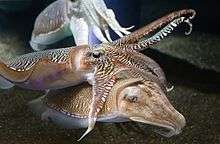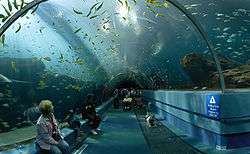Georgia Aquarium
|
| |
 Georgia Aquarium | |
| Date opened | November 23, 2005 |
|---|---|
| Location | Atlanta, Georgia, U.S. |
| Coordinates | 33°45′46″N 84°23′41″W / 33.76278°N 84.39472°WCoordinates: 33°45′46″N 84°23′41″W / 33.76278°N 84.39472°W |
| Number of animals | More than 100,000[1] |
| Number of species | 500[1] |
| Volume of largest tank | 6.3 million US gallons (24,000 m3) |
| Total volume of tanks | More than 10 million US gallons (38,000 m3)[2] |
| Annual visitors | 2.2 Million[3] |
| Memberships | AZA[4] |
| Website |
www |
The Georgia Aquarium is a public aquarium in Atlanta, Georgia, USA. It is the largest aquarium in the Western Hemisphere, housing thousands of animals and representing several thousand species, all of which reside in 10 million US gallons (38,000 m3) of marine and salt water.[1][2] It was the largest aquarium in the world from its opening in 2005 until 2012, when it was surpassed by Marine Life Park in Singapore.[5]
Businessman Bernard Marcus credits his 60th birthday dinner, held at the Monterey Bay Aquarium, with inspiring him to build a great aquarium for Atlanta; his subsequent $250 million donation provided the bulk of the money needed to build and stock the new facility.
The Aquarium's notable specimens include whale sharks, beluga whales, bottlenose dolphins, and manta rays.[6][7]
History
In November 2001, Bernard Marcus announced his vision of presenting Atlanta with an aquarium that would encourage both education and economic growth. After visiting 56 aquariums in 13 countries with his wife, Billi, he donated $250 million toward what was to become Georgia Aquarium.[8] Corporate contributions totaling an additional $40 million[8] allowed the aquarium to open debt-free.
Jeff Swanagan, the Aquarium's founding president and executive director until 2008,[9] is largely credited with the creation of the aquarium,[9][10] from the design of the structure to the procurement of animals for the exhibits.[9]
The aquarium is in downtown Atlanta on land donated by The Coca-Cola Company, just north of Centennial Olympic Park and near the Georgia Dome, the Georgia World Congress Center, Philips Arena, and CNN Center. Its blue metal-and-glass exterior is meant to evoke a giant ark breaking through a wave. The world’s largest when it opened in November 2005, the aquarium encompasses 550,000 square feet (5.1 ha; 13 acres) of covered space; its exhibits hold 8,000,000 US gallons (30,000 m3) of fresh and salt water.
After 27 months of construction the aquarium opened on November 21, 2005, with 60 animal habitats. Though the non-profit aquarium's admission charges are among the highest in the United States, attendance has far exceeded expectations, with 1 million visitors in the first 100 days,[11] 3 million by August 2006, 5 million by May 2007, and 10 million by June 2009.[12] The aquarium is part of the Smithsonian Affiliations program.[13]
Collection
The Georgia Aquarium contains tens of thousands of fish and other sea creatures, representing several hundred species.
The aquarium is the only institution outside of Asia housing whale sharks,[9] which are kept in a 6.3-million-U.S.-gallon (24,000 m3) exhibit—the aquarium as a whole was designed around the whale shark exhibit.[9] Their importation from Taiwan (by air, truck and boat) had never been attempted previously. They were taken from Taiwan's annual fishing kill quota, under which they would have been eaten had they not been purchased by the aquarium. The aquarium's most famous specimens were four young whale sharks from Taiwan named Ralph, Norton, Alice, and Trixie, after the primary characters from The Honeymooners. Ralph and Norton died in 2007[14] but that same year the aquarium received two more whale sharks ("Taroko", commemorating Taroko Gorge National Park, and "Yushan" after Taiwan's Jade Mountain) just before a ban on capture of that species took effect.[14][15]
The aquarium has also been home to as many as five 11-foot (3 m) beluga whales at once. Males Nico and Gasper, acquired from an amusement park in Mexico, were joined by three females on breeding loan from the New York Aquarium: Marina, Natasha and Natasha's daughter, Maris. After Gasper[16] and Marina died in 2007, the belugas were transferred to SeaWorld San Antonio, where Nico died in 2009.[17] In 2010, Maris and a new male, Beethoven, were returned to the Georgia Aquarium while Natasha remains with a potential mate in San Antonio.[18] Two young belugas, Grayson (male) and Qinu (female), also from San Antonio, were added in November 2010.[19] Before transferring to the Shedd Aquarium in 2014, Beethoven fathered calves with Maris in 2012 and 2015. Maris died of a heart defect in 2015. In 2016, Grayson was sent to Shedd Aquarium while SeaWorld Orlando's Aurek and Maple and Shedd Aquarium's Nunavik arrived on loan at Georgia Aquarium.

A manta ray, Nandi, that had been accidentally caught in nets protecting the South African coast from sharks, joined the Ocean Voyager exhibit in 2008 as the first manta ray on display in the country;[20] the Aquarium is one of only four sites in the world displaying one.[21] A second manta ray, Tallulah, was added in September 2009,[7] joined in 2010 by female named Billi,[22] and in 2012 by a male. The animals range in size from 10–13 ft wingspans.
Exhibits
The aquarium's animals are displayed in five galleries: Tropical Diver, Ocean Voyager, Cold Water Quest, River Scout, and Dolphin Tales. Each corresponds to a specific environment.
The first exhibit, Southern Company River Scout, reflects regional environments. It features an overhead river where visitors can see North American fish from the bottom up. In addition to local specimens, this exhibit displays piranha, electric fish and other unusual freshwater life.
Next to River Scout is the AT&T Dolphin Tales gallery. This is the aquarium's newest addition (opened in April 2011) and houses the indoor dolphin stadium. The aquarium houses thirteen bottlenose dolphins, though this number fluctuates from time to time. The show lasts about 20 to 30 minutes and includes an informative/educational videos about the dolphins 30 minutes before the show. Admission to the AT&T Dolphin Tales show is included in general admission.
Current Dolphins presently living there: Niele(M), Kenobi(M), Polka(M), Sydney(M), Pacino(M), Phebe(F), Pukanala(F), Kei(M), Makana(M), Briland(M), Salvador(M), Luna(F), Bermudiana(F)
[23] Guests also can see the dolphins during non-show times.
The third section of the aquarium, Georgia Pacific Cold Water Quest, features animals from the polar and temperate regions of the world and contains most of the mammal species in the aquarium's collection. This exhibit includes beluga whales in the aquarium's second largest habitat (after Ocean Voyager), sea otters, Japanese spider crabs, weedy sea dragons, and African penguins.[24]
The largest exhibit, Ocean Voyager built by Home Depot, contains 6.3 million US gallons (24,000 m3) of water[25] and several thousand fish.[26] It measures 284 ft × 126 ft (87 m × 38 m) and the depth ranges between 20 and 30 ft (6.1 and 9.1 m), making it the largest indoor aquatic habitat in the world.[26] This exhibit is designed to feature the life of the Mesoamerican Barrier Reef System and showcases the aquarium's whale sharks, as well as a 100 ft (30 m) underwater tunnel and one of the world's largest viewing windows.
The fifth exhibit, Tropical Diver presented by Southwest Airlines, features mainly Indo-Pacific tropical fish. The largest habitat in the exhibit is a 164,000-US-gallon (620,000 L) reef featuring many species of fish. The aquarium also cultivates its own live coral, some of which can be seen on this large reef. Other animals in this gallery include sea horses, garden eels, jellyfish, clownfish, shrimp, lobsters, turkeyfish, and many other tropical fishes.
The aquarium also features a "4D" movie "Deepo's Undersea 3D Wondershow", a section with exhibits of frogs and other attractions, including the Ocean Voyager – Journey With Giants exhibit hall, where the Chedd-Angier-Lewis production company, with Electrosonic Inc., has produced the Open Ocean Touchwall, a dynamic, interactive projection for species identification. This is a virtual aquarium where larger than life, fully articulated 3-D renderings of Open Ocean fish swim across six panels assembled to simulate a tank. Guests may reach out and place hands or fingers on the fish. As they do so, fun and informative content bubbles appear to educate the guest about the particular species they have chosen.
Also, in 2009, the "Titanic Aquatic" exhibit opened, which features a walk-through of what it was like on the ship RMS Titanic. The exhibit was at the aquarium until September 7, 2009. The Georgia Aquarium then hosted the world debut of Planet Shark: Predator or Prey: The Exhibition. The exhibit focused on dispelling myths and sharing facts to help create a better understanding of sharks. It was open through April 2011, and featured shark jaws, teeth and fossils, full scale shark models made from real specimens and more.
A new sea lion exhibit is expected to open in Spring 2016, replacing the Suntrust Georgia Explorer gallery.[27]
Research and conservation
According to founder Bernard Marcus, the aquarium's conservation and environmental mission is just as important as its status as an attraction. Long before opening, the aquarium was already working with Georgia Tech and Georgia State University in Atlanta and the University of Georgia in Athens to help save endangered species through education and research programs.
The acquisition of the male beluga whales, previously suffering in an inadequate environment, was hailed by Marcus as a prime example of the type of conservation activities the Aquarium should be involved with. Roughly 100 tarpon stranded in a tidal pool at Skidaway Island, off the Georgia coast, were rescued for the collection. Coral used in exhibits at the aquarium is man-made in a collaboration between Georgia Tech and the University of the South Pacific, produced by suspending blocks of pumice over a reef near the village of Tagaqe, Fiji for eight months so that seaweeds and reef invertebrates could establish colonies.
The aquarium is involved in several research initiatives that focus on whale sharks in the Yucatán Peninsula, beluga whales in Alaska, penguins in South Africa, manatees in Quintana Roo, Mexico, loggerhead sea turtles on the Georgia coast and spotted eagle rays in Sarasota, Florida.
Its newest research project centers on bottlenose dolphins in the Indian River Lagoon. These animals serve as indicators of environmental health because they are permanent residents of the lagoon and are at the top of the food chain. The aquarium is partnering with Florida Atlantic University and the federal government to monitor the health of these animals as well as identify potential threats from pollution and emerging infectious diseases.
New facilities and programs
In May 2008, the aquarium announced plans to build a $110 million expansion for a new dolphin exhibit. The expansion covers 84,000 square feet (7,800 m2)[9] and contains 1.8 million US gallons (6,800 m3) of water.[2] Located on the west side of the facility, the exhibit features space for live presentations, observation windows, and opportunities for visitors to interact with animals.
Construction began later in 2008 and was completed in late 2010. During part of the construction, the aquarium's three beluga whales were temporarily relocated to SeaWorld San Antonio.[28] Beluga whales are very sensitive to sound, and while officials had not noted any excessive amounts of stress, it was decided to remove them anyway and eliminate the possibility.[28] Unexpectedly, one of the three belugas, Nico, died at SeaWorld on October 31, 2009; a preliminary necropsy was unable to determine if Nico's death was caused by the move or by something else.[17]
The AT&T Dolphin Tales show opened to the public on April 2, 2011,[29] and has been controversial.[30] Some view it as purely being a theatrical show with live actors and feel-good songs befitting of Disneyland while others argue that from entertainment comes education.
On January 1, 2011, the aquarium purchased Marineland of Florida for a reported $9.1 million.[31] The seller was Jim Jacoby, a metro Atlanta developer and member of the Georgia Aquarium board of directors, who bought the park in 2004 and re-developed it.
Controversy
In 2012, the beluga whale Maris gave birth to a female calf. After less than a week, the calf, who was born underweight, died. Although mortality rates of calves born to first time mothers is extremely high, even in wild populations,[32] Maris's second calf—born on Mother's Day in 2015—would survive less than a month. Maris herself died in October of the same year,[33] reigniting the debate as to whether the captive beluga breeding program was humane or successful.
In 2015, the aquarium applied to import 18 belugas from Russia; it had previously placed an order for their capture and planned to send them on breeding loans to partnered parks such as Shedd Aquarium[34] and SeaWorld, though SeaWorld ultimately opted out of the agreement.[35] However, the permit was denied by the National Marine Fisheries Service, prompting Georgia Aquarium to sue. In September 2015, a federal district court ruled that "Georgia Aquarium failed to demonstrate that its permit would not result in the taking of additional animals beyond those authorized by the permit", and that the denial would stand.[36]
Images
 Aerial view of the aquarium
Aerial view of the aquarium Guests observe Navy divers as they dive in a tank at the Aquarium
Guests observe Navy divers as they dive in a tank at the Aquarium Whale shark in the viewing theater
Whale shark in the viewing theater Cuttlefish at the aquarium
Cuttlefish at the aquarium The petting tank featuring bonnethead sharks and cownose rays
The petting tank featuring bonnethead sharks and cownose rays The Ocean Voyager exhibit tunnel
The Ocean Voyager exhibit tunnel Ocean Voyager exhibit tunnel
Ocean Voyager exhibit tunnel
Notes
- 1 2 3 Georgia Aquarium:Georgia Aquarium to Be Home to More Than 100,000 Fish.Retrieved 24 December 2013
- 1 2 3 Georgia Aquarium: AT&T Dolphin Tales. Retrieved 24 December 2013
- ↑ Abel, David (2016-08-02). "Top aquariums in the US, in terms of visitors". Boston Globe. Retrieved 2016-12-02.
- ↑ "List of Accredited Zoos and Aquariums". aza.org. AZA. Retrieved 2011-03-12.
- ↑ "Aquarium sets Guinness record". Associated Press. Atlanta Journal-Constitution. 2010-08-23. Archived from the original on August 26, 2010. Retrieved 2010-08-24.
- ↑ http://community.oceana.org/blog/2008/08/manta-lanta Archived November 19, 2008, at the Wayback Machine.
- 1 2 Andres, Bob (2009-09-03). "Second manta ray at Georgia Aquarium". The Atlanta Journal-Constitution. p. A1.
- 1 2 Huettel, Steve (2009-06-30). "Jeff Swanagan, who turned around Florida Aquarium, dies at 51". St. Petersburg Times. Retrieved 2009-07-12.
- 1 2 3 4 5 6 Tharpe, Jim (2009-06-30). "Georgia Aquarium creator dies". Atlanta Journal Constitution. Retrieved 2009-07-12.
- ↑ Morris, Mike (2009-06-29). "Former Georgia Aquarium director Jeff Swanagan dies". Atlanta Journal Constitution. Retrieved 2009-07-12.
- ↑ No fish story: Aquarium draws million in 3 months David E. Williams, CNN, 1 March 2006. Retrieved 24 August 2006
- ↑ Davis, Mark (2007-05-23). "Aquarium welcomes 5 millionth visitor". Atlanta Journal-Constitution. Archived from the original on 2007-09-30. Retrieved 2007-05-24.
- ↑ "Georgia Aquarium". Affiliate detail. Smithsonian Affiliations. 2011. Retrieved 16 Jul 2011.
- 1 2 Simons, Craig (2007-05-25). "Taiwan approves export of 2 whale sharks". Atlanta Journal-Constitution. Archived from the original on 2007-05-28. Retrieved 2007-05-25.
- ↑ Davis, Mark (2007-06-01). "Two whale sharks join trio at Georgia Aquarium". Atlanta Journal-Constitution. Archived from the original on 2007-09-30. Retrieved 2007-06-01.
- ↑ Gasper Press Release
- 1 2 Howard Pousner (2009-11-02). "Aquarium beluga dies". Atlanta Journal-Constitution. Retrieved 2009-11-02.
- ↑ Howard Pousner (2010-03-02). "2 Belugas finally go on view at the Georgia Aquarium". Atlanta Journal-Constitution. Retrieved 2010-03-02.
- ↑ Georgia Aquarium welcomes 2 new beluga whales
- ↑ Leon Stafford (2008-08-25). "Georgia Aquarium adds 9-foot manta ray". Atlanta Journal-Constitution. Retrieved 2008-08-25.
- ↑ "About Nandi". Georgia Aquarium. Retrieved 2008-08-27.
- ↑ http://www.georgiaaquarium.org/newsroom/pressdetail.aspx?id=159
- ↑ http://www.georgiaaquarium.org/dolphin-tales/
- ↑ Georgia Aquarium: Cold Water Quest Exhibit. Retrieved 14 September 2013
- ↑ Georgia Aquarium: Ocean Voyager. Retrieved 14 September 2013
- 1 2 Georgia Aquarium: Ocean Voyager Exhibit. Retrieved 14 September 2013
- ↑ http://www.bizjournals.com/atlanta/print-edition/2015/05/22/georgia-aquarium-plans-new-40m-sea-lion-exhibit.html
- 1 2 Howard Pousner (2009-10-05). "Georgia Aquarium's beluga whales sent to Texas". AJC.com. Retrieved 2009-10-06.
- ↑ Terry Gardner. "Dolphins Splash Down at the Georgia Aquarium". Chicago Tribune. Retrieved 2011-03-08.
- ↑ Melissa Ruggieri. "New dolphin exhibit triggers debate about captivity". Atlanta Journal-Constitution. Retrieved 2011-03-30.
- ↑ Ruggieri, Melissa (3 January 2011). "Georgia Aquarium buys Florida's Marineland". ajc.com. Atlanta Journal-Constitution. Retrieved 4 January 2011.
- ↑ "Georgia Aquarium's baby beluga dies days after critical birth". wsbtv.com. Retrieved 2012-10-16.
- ↑ Markiewicz, David. "Maris, much-loved beluga whale at Georgia Aquarium, dies". Ajc.com. Aj. Retrieved 17 July 2016.
- ↑ "Georgia Aquarium Application to Import 18 Beluga Whales (File No. 17324)". http://www.nmfs.noaa.gov/. Retrieved 2012-10-16. External link in
|work=(help) - ↑ Pedicini, Sandra. "SeaWorld says it won't take beluga whales captured in Russia". Orlando Sentinel. Retrieved 1 August 2016.
- ↑ "IN THE UNITED STATES DISTRICT COURT FOR THE NORTHERN DISTRICT OF GEORGIA ATLANTA DIVISION" (PDF). Retrieved 17 July 2016.
References
- Tharpe, Jim (June 14, 2005) Surprise at aquarium: 100,000 fish, in from AsiaAtlanta Journal-Constitution
- Seabrook, Charles (July 8, 2005) Georgia Aquarium acquires belugas from MexicoAtlanta Journal-Constitution
- Tharpe, Jim (August 14, 2005) Aquarium's lofty goal: 'Save planet' Atlanta Journal-Constitution
- Tharpe, Jim (September 7, 2005) 6 companies help make up aquarium financing shortfall Atlanta Journal-Constitution
External links
| Wikimedia Commons has media related to Georgia Aquarium. |